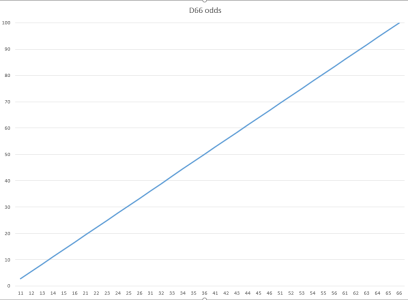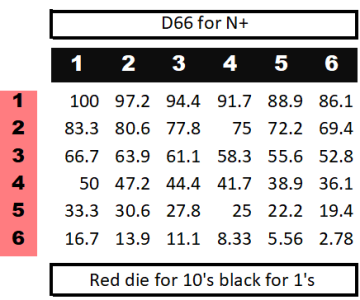How do you apply DMs to the d66 roll?
Would it not be easier just to use d100?
nd6 rolls produce a distribution curve for n>3
2d6 is more of a triangle than a curve, but you can still treat it as a distribution curve for standard deviation purposes.
standard deviation follows the 68–95–99.7 rule
In this case it is more of a straight percentage roll than anything calling for a mod, such as a check.
The trouble I had was that if I was looking for a 50% chance I would be using a d6, because nd6 doesn't give a clean break at 50%, and other times I would 2,3,or 4d6 to hit the percentage I wanted, and higher numbers of d6 tend to move slowly at the ends and quickly in the middle, , for example it's hard to roll 66% on 2 or 3 d6 so I found myself switching between 1D6, 2D6, 3D6 or 4D6 depending on the percent chance I wanted, or rounding 6 to 8 percent to make the numbers fit on a 2d6,3d6 or 4d6 table,
It was unwieldy switching between different dice rolls for each table,
The problem was that even though 2d6 has 36 permutations you only use 11 combinations of them in a 2-12 chart. And at points in the table the odds jump by 16%. So I hit on the Idea of using a d66, it's still just 2 dice, and it's the same 2 dice, not 2d10, for example. So you can fit a lot more percentages on the chart,and they space out more evenly.
For example of you wanted 8 semi equal possibilities you would assign them 4 or 5 of the 36 possibilities.
1= 14-
2 = 23-
3= 31-
4 =36-
5= 44-
6= 53-
7= 61-
8= 62+
That gives you either 11% or 12% chance of any number, You could do something similar for 10 possibilities.
Much harder to do with 2d6
At least that's my thinking, I'm just not sure how easy it would be to get someone else to understand such a table.



